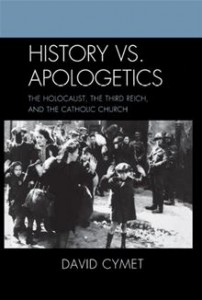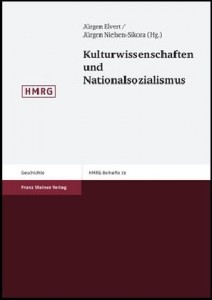ACCH Quarterly Vol. 17, No. 1, March 2011
Review of David Cymet, History vs. Apologetics: The Holocaust, The Third Reich, and the Catholic Church (Lanham, MD: Lexington Books, a division of Rowman & Littlefield Publishing Group, 2010). 489 pp. ISBN 978-0739132937.
By Robert Ericksen, Pacific Lutheran University
This book is a somewhat surprising entry in the ongoing wars over Catholics, the Holocaust, and Pius XII, especially in terms of the background and experience of its author. David Cymet, born and raised in Mexico City, traveled to the United States in 1944 as one of the first two Latin American students to study at an American rabbinical school. After four years at the Mesivta Torah Vodaath in Brooklyn, he returned to Mexico to study architecture, followed by an academic career teaching architecture at his alma mater, the National Polytechnic Institute of Mexico, and then at the National University of Mexico. He also served the Mexican government in various capacities from the 1950s through the 1970s, for example, in the National Housing Institute and in the Ministry of Human Settlements. In the 1980s he moved to the United States, where he began working for the New York City Department of Education in 1986, also earning a doctorate at the University of Delaware in 1991. Described in his author’s note as “a student of the Holocaust since his earliest youth,” Cymet spent the first decade of the twenty-first century – presumably retired from his multiple careers – researching and writing this book.
 We might be surprised when a trained architect from Mexico, after a distinguished public and academic career, writes a 500-page book on history for Rowman and Littlefield Publishers. We will be less surprised when the subject is the Holocaust. Furthermore, though it is almost fifty years since Rolf Hochhuth’s The Deputy became a first salvo in the Pius XII wars, the level of controversy has scarcely diminished. Thus we will not be surprised that David Cymet, a Jewish man raised in a Catholic country, has chosen to concentrate on the Catholic Church, theVatican, and the wartime Pope, and that he comes to harsh conclusions.
We might be surprised when a trained architect from Mexico, after a distinguished public and academic career, writes a 500-page book on history for Rowman and Littlefield Publishers. We will be less surprised when the subject is the Holocaust. Furthermore, though it is almost fifty years since Rolf Hochhuth’s The Deputy became a first salvo in the Pius XII wars, the level of controversy has scarcely diminished. Thus we will not be surprised that David Cymet, a Jewish man raised in a Catholic country, has chosen to concentrate on the Catholic Church, theVatican, and the wartime Pope, and that he comes to harsh conclusions.
Cymet begins with the observation that Jews were not in a position to critique the Catholic Church in the first years after 1945. They had much more pressing concerns, such as immediate assistance to survivors, finding visas for DPs, and securing the place of Jews inPalestine(xi). Cymet then gives credit to major authors who began to probe the role of the Catholic Church, including Hochhuth, Saul Friedlander, Guenter Lewy, Klaus Scholder, and Carlo Falconi, as well as later figures such as Michael Phayer, Gitta Sereny, and Fr. John Morley, SJ (xiv-xvi). “The aim of this study,” he says, “is to look critically at the polemic and present a view of the issues within the wider context of their contemporary political and ideological background” (xvi).
There is no doubt that Cymet tilts toward the more critical observers within the “wider context.” His opening statement about “defenders” of the Catholic Church, who provide the “apologetics” mentioned in his title, is harsh indeed: “Unlike their not-so-distant cousins – the Holocaust deniers – they did not claim that the Holocaust never happened, but rather chose to take cover behind half-truths, misrepresentations, and subtle distortions. At the margin of legitimate discussion beholden to historical truth, the defenders of all sorts aimed at derailing the discussion by creating a thick cloud of confusion and doubt” (xvi).
Flaws can be found in this book. In one chapter he mentions Guenter Lewy correctly, but then calls him Lewy Güenther in endnotes, repeating this mistaken last name and mistaken spelling through a sequence of five notes (13). He praises Doris Bergen’s work, but in his bibliography he cites her as the author of In God’s Name: Genocide and Religion in the Twentieth Century (2000), rather than correctly noting the editors, Omer Bartov and Phyllis Mack (461). He is careless of chronology at times, such as when he says Guenter Lewy “reacted” to We Remember (1998) and its claim that Cardinal Faulhaber was a defender of Jews. When Lewy, as quoted, called it “little short of falsification of history when Faulhaber’s sermons in 1933 are hailed . . . as a ‘condemnation of the persecution of Jews,’” Lewy may have been right; but his statement in 1964 was not a reaction to aVatican publication of 1998 (9).
Despite these lapses and despite Cymet’s occasionally impassioned prose, with words such as “mean-spirited” and “diabolical” signaling his point of view, his thorough and detailed telling of the story makes for a sobering read. He accepts David Kertzer’s view (The Popes against the Jews: The Vatican’s Role in the Rise of Modern Anti-Semitism, 2001) that Christian anti-Judaism cannot be seen as significantly different from racial antisemitism, and he finds many Catholic statements in Germany and elsewhere in which common cause with racial antisemites is clearly expressed. His chapter on “Catholic Europe ‘Defends’ Itself from the Jews” begins with Humani Generis Unitas, Pius XI’s unfinished encyclical often regarded as a significant attack on antisemitism. But Cymet notes the residual antisemitism in those parts which justify the “social separation” of Jews and the justification for Christians defending themselves against Jews, “as long as the unbelief of the Jewish people persists” (142). He then describes anti-Jewish legislation written with Catholic support in Poland,Italy,Hungary, and Slovakia prior to the war (150-63). In a chapter on “The Final Solution in Christian Europe” (305-74), he emphasizes the obvious, that this murder took place in Christian countries. He also points out the instances in which Catholic leaders protested in favor of Catholics of Jewish descent, but not, despite many entreaties, against the deportation and murder of Jews as Jews.
Cymet’s chapter on “Vatican Response to the Final Solution” first notes that the Klerusblatt in Germany described the Nuremberg Racial Laws of 1935 as an “indispensable safeguard for the qualitative make-up of the German people” (375). He also describes Slovakia, Croatia, Hungary, Italy, and Vichy France as “clero-Fascist” countries which increased the severity of their anti-Jewish laws from 1938 to 1942, until they fed into the killing process itself. What was the Vatican response? Here Cymet points out the many avenues of information available to the Vatican, while stressing the silence that ensued. In a segment on “The Rome Deportations, a Paradigm of Vatican Policy,” he quotes Michael Phayer: “No other event placed Pius XII in greater physical proximity to the Holocaust than the deportation of the Roman Jews.” The paradigm for Cymet is seen in his conclusion that, here as elsewhere, “the Church stood calmly at the sidelines” (387).
Cymet makes extensive use of Kertzer, Morley, Lewy, Phayer, Saul Friedlander, and a host of others. I do not think he approached this project from a place of neutrality, with the thought that he might end up defending the Catholic Church, for example. However, he prepared his brief energetically. Those who would argue for the defense must acknowledge that his evidence for the prosecution weighs heavily. He identifies a burden of anti-Jewish prejudice, human insensitivity, and silence in the face of evil which fitted itself too comfortably within the Catholic nations, the “bloodlands,” of Central Europe.


